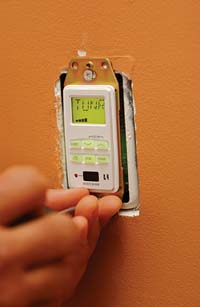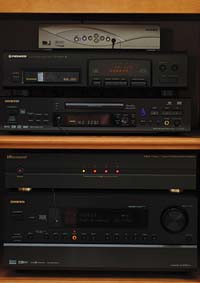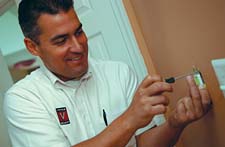

City of Bayamon, Puerto Rico
People are more comfortable doing business in Bayamon, Puerto Rico, now that the city has installed a 136-camera video surveillance system that is centrally monitored by police and civilian staff.“The primary goal was to revitalize the center of town to make it more secure,†says Hector Sanchez, general manager of the network systems division for Bonneville Construction, SE, which installed the network. “Bayamon had an increase in crime and a decrease in commercial activities.†Since the system was installed, police have caught several people stealing cars or merchandise.
The city wanted to make sure that material captured on video would be usable in court and therefore made the decision to continuously record all cameras at 30 frames per second. Fifteen days of material are kept on a network-attached storage (NAS) system, after which time the video is moved to tapes, which are stored for one year. The requirement to send 30 frames per second from every camera to the central monitoring facility drove the need for a high-bandwidth network. The system runs on a gigabit local area network that Bonneville installed solely for that purpose. Because no fiber was available, the company dug trenches on city property and installed its own fiber to support the network.
Another concern was that some of the areas to be covered were quite far from one another. “We had to use different types of communication technology to tie it all in,†Sanchez says.
Particularly challenging was a jogging trail, measuring about three miles long, which was a mile and a half from the center of town and was to be protected by 39 cameras. Fiber would have been too expensive and Bonneville was concerned about using traditional wireless options because there was a high-voltage power substation between the jogging trail and the monitoring facility. “Power lines create a lot of EMI interference so we try to stay away from putting RF near them,†Sanchez says.
Because Bonneville also does a lot of work for communications companies, Sanchez was familiar with free space optics, a wireless technology that does not use radio frequency transmission. Instead it uses lasers – in a manner similar to fiber optic transmission – to send data through the air.
“It took less than one day to install, align it and make it work, and it’s working great,†Sanchez says. Surprisingly, the system seems to be immune from problems with rainfall. According to a famous Spanish song, “It rains every day in Bayamon†– and Sanchez adds, “it rains hard.†But the company has not had any problems since the system was completed earlier this year.
The manufacturer that Bonneville uses has a Web site where customers can enter data rates and the distance to be covered and, based on that, a specific model is recommended. Like many other types of wireless systems, a free space optic system requires line of site – and Sanchez cautions against installing such a system without the proper tool. “You have to get an alignment tool for the specific model,†he notes.
The downside of free space optics is its cost – about $80,000 to $90,000, compared with about $25,000 for an equivalent RF system. But in comparison with fiber, which would have run between $300,000 and $400,000, it’s a bargain.
Because Bayamon has plans for developing the area adjacent to the running track, Bonneville planned for future expansion by using drop and repeat switches that can be installed in a daisy chain manner so that additional cameras can be easily added to the chain.
At press time, Bonneville was beginning work on the third of three phases of the Bayamon installation – a single mode fiber link to another part of town.

TIP FROM THE FIELD
“Power lines create a lot of EMI interference so we try to stay away from putting RF near them,†Sanchez says.
Sportsman’s Warehouse
When a retailer handles high-ticket items, including high-power binoculars and guns, it’s particularly important to prevent burglary, rather than to simply detect it after it’s in progress. This is the challenge facing Sportsman’s Warehouse, which has 22 locations nationwide.“It takes a long time to break into one of our stores,†says Mike Van Orden, chief technology officer for the retailer. “We have heavy metal doors with magnetic locks, but if someone puts in enough time and effort, they’ll get in.â€
When each of its stores was opened, an alarm and a video surveillance system was installed. But with a break-in at one location, the alarm systems failed to prevent a burglary because the alarm did not go off until the contacts were tripped. “We dispatched authorities right away and within two minutes, the police came, but the person was in and out before the police got there,†Van Orden says.
Determined not to let this happen again, Van Orden undertook a major upgrade to all Sportsman’s Warehouse locations that included installing outdoor pan/tilt/zoom cameras that could be controlled locally and remotely from a central in-house monitoring facility, to which all stores would be connected. “We wanted a 20- to 30-minute head start,†Van Orden says. “Now if there is motion on any of the cameras outside, it will set off an audible and visual alarm to the surveillance officer who can take control of the camera and see what’s going on in the parking lot.â€
Van Orden called upon Mountain Alarm’s Boise, Idaho, branch to make the system upgrade, which included adding as many as 12 cameras to each store (at least three of which would be outside). Mountain Alarm also would replace time-lapse VCRs and older digital video recorders (DVRs) with new DVRs that would have ample storage capacity. Additionally, each store would have to be connected via a wide area network to the new central monitoring facility at Sportsman’s Warehouse corporate headquarters.
One factor that was particularly critical was to properly match the DVR storage capacity with the cameras (32 at a minimum) in each store. Cameras were set to record only when motion was detected, but during the store hours, recording would be virtually continuous because of ongoing movement within the store. To ensure video clarity, Sportsman’s Warehouse wanted to record at 7 frames per second. (The previous system had recorded at only one or two frames per second.) The company also wanted to be able to retain at least 30 days of video at a time.
“The pan-tilt-zoom cameras take up more memory. They’re always recording because they’re always moving. The images change more and are refreshed more,†says Tom Kyle, project manager for Mountain Alarm. To ensure ample storage capacity, Mountain Alarm used three 200-gigabyte hard drives for each DVR that would handle 16 PTZ cameras. The vendor set up the hard drives so that when one was full, recording would continue on the next two until they were full before recording over the first hard drive. DVRs connected to fixed cameras had 360-gigabyte hard drives.
At press time, Mountain Alarm had completed the upgrades for nearly all locations and Sportsman’s Warehouse was putting finishing touches on the central monitoring facility, which would be backed up by Mountain Alarm monitoring.
TIP FROM THE FIELD
Make sure to have sufficient DVR storage capacity for the number of cameras in an installation. Tell the vendor whether the DVR will record continuously or on motion, the business hours of the location, the number of cameras and whether they are pan/tilt/zoom or fixed, and the number of days you want to store. Your vendor should be able to recommend the right size hard drive and, if needed, connect multiple hard drives together to act as one.
An Ultra High Security Residence
When Security Equipment Inc. (SEI) of Omaha, Neb., was engaged to install a video surveillance system for a prominent area resident, residential sales manager Paul Melingagio quickly realized that this was a far from ordinary job. The company was brought in before the 25,000 square foot home was constructed on a lot measuring more than 20 acres.“The house was built by a builder of large commercial buildings,†Melingagio says. “It has self-contained power and seismic protection.â€
The video surveillance system was to work in combination with a home automation and access gate system to provide a very high level of intrusion detection. SEI installed a sophisticated video system that would help ensure that no trespassers could gain access to the property without being seen. As an added precaution, SEI devised a method to help ensure that no additional vehicles could slip through when only one vehicle was granted entry.
To reach the residence, vehicles must pass through two access gates separated by a distance of approximately six city blocks. When a vehicle reaches the first gate, a signal is relayed to the home automation system and an image from the surveillance camera at the gate appears on a monitor. An employee responsible for maintaining the property can view the image, speak to the driver, and let the vehicle in through the first gate. As the vehicle drives towards the second gate, it passes next to a brick wall into which SEI installed two covert pan-tilt-zoom cameras with illumination. The groundskeeper can bring up images from either of those cameras on the monitor to ensure that no additional vehicles slipped in behind the first one. If the groundskeeper doesn’t like what he sees, he can deny passage through the second gate, where another surveillance camera is located.
The trickiest part of the installation was finding cameras, illumination and housings that would fit into the brick wall and blend in with it. “The space we had to work with was a given,†Melingagio says. “We knew it would need to be a bullet camera and we found one that would work through trial and error.
SEI had a sheet metal fabricator construct boxes to house the cameras out of several different materials and then selected the material that would work the best – a flexible stainless steel box that could be powder coated to blend in with the wall. The primary goal was aesthetic – to avoid changing the look of the wall. “If you look quickly, you don’t know it’s not a brick,†Melingagio says. “If you paid attention and walked up and down, you might notice it. But the way the box is made, you would probably think it was a light.â€
Melingagio’s advice for how to handle such complex installations? Diplomacy in working with other contractors – in this case, the organization responsible for the home automation system – is critical. By explaining the downside to using unfamiliar equipment, SEI persuaded all concerned that the installation should use manufacturers and models that SEI was accustomed to installing and servicing. “If you hand technicians too many products, it takes them longer to service each one because they may not be familiar with it, and then people start to complain about service time.â€
Palmetto International Preparatory School
When a pre-school counts numerous children of wealthy families among its students, the need to guard against kidnapping is a key concern. Recognizing this, the Palmetto International School, a newly constructed pre-school in Greenville, S.C., decided to install video surveillance cameras throughout its premises, including every classroom. The system, installed by Blue Ridge Security Systems of Anderson, S.C., also includes a monitor for each camera. A bank of monitors is installed in the wall across from a reception desk, which is attended throughout the school day. Parents are assigned a personal identification number (PIN) to enter the school, enabling the school to keep an audit trail of their comings and goings.One of the most challenging aspects of the installation was social, rather than technical. “We had to sell the owners on the need so that they could go to parents and justify the existence of the system,†says Ed Hubbard, senior account representative for Blue Ridge. “Everyone at first was concerned about the Big Brother aspect, but the system goes a long way to reduce liability if a child says he was hit or struck.â€
The video system was planned before the building was constructed, which was a plus in many ways. Blue Ridge was able to run its wiring while the walls were open, which simplified that process immensely. But the most challenging aspect of the job was determining the right camera lens to use in rooms that had not yet been constructed when the system was planned.
“We tried to avoid using a lens so wide that it covered the whole room with no detail or one with great detail that couldn’t see the whole room,†Hubbard says. The company initially worked from blueprints to determine the type of lens. But after some rooms were furnished, Blue Ridge sometimes found that the lens that had been selected wasn’t the best choice. “We had to relocate some cameras to provide broader coverage.â€
In this case, Blue Ridge solved the problem by repositioning cameras. But the company learned a valuable lesson from that job and has now devised a better solution. “We now use variable focal-length lenses,†Hubbard says. “This allows you to adjust the field of view without replacing the lens.â€